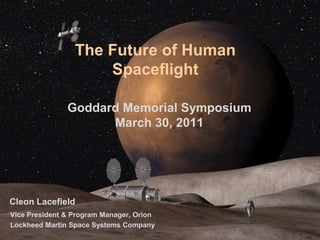
The Future of Human Spaceflight
- 1. The Future of Human Spaceflight Goddard Memorial Symposium March 30, 2011 Cleon Lacefield Vice President & Program Manager, Orion Lockheed Martin Space Systems Company
- 2. Orion Crew Exploration Vehicle Deep Space, Long Duration Exploration Crew Module crew and cargo transport Service Module propulsion, electrical power, fluids storage Launch Abort System emergency escape during launch Spacecraft Adapter
- 3. Orion’s First Flight Test National Aeronautics and Space Administration
- 4. Crew Module Arrives in Denver
- 5. Thermal Protection Systems National Aeronautics and Space Administration
- 6. Propulsion Testing Orion Main Engine Injector Test Crew Module Thruster Test Service Module Thruster Test National Aeronautics and Space Administration
- 8. Stepping Stones to Exploration 2031-2035 Explore Mars from Deimos 2023 Deimos Scout 2019, 2023, 2025, 2029 Humans Explore Asteroids 2018 Explore the Moon’s Far Side from Earth-Moon L2 Point 2017 Human Lunar Flyby Stepping Stones: a series of increasingly challenging exploration missions, building incrementally towards America’s long-term goal of exploring Mars. Each mission will address science objectives relating to the formation of the solar systemand the origins of life. 2016 Asteroid Survey 2017 Asteroid Scout 2016 SLS Test Flight
Hinweis der Redaktion
- Activated at ground level during the Pad Abort 1 test, Orion’s launch abort system propelled the crew module 500 feet in the first three seconds of flight. During the total 97 seconds of flight, the launch abort system reached an altitude of 5,000 feet, traveling at a maximum speed of 600 miles per hour.The abort motor propellant burns at a temperature of 4,456 degrees Fahrenheit, nearly half the temperature on the surface of the sun. While that temperature is hot enough to boil steel, the interior temperatures of the crew module measured only 75 degrees Fahrenheit during the Pad Abort 1 flight test.Combustion gases exiting the motor nozzles travel at a speed of 2,600 miles per hour, more than three times the speed of sound and two times the speed of a bullet shot from a rifle.
- Having arrived in Denver, the crew module will be integrated with the heat shield and thermal protection backshell before undergoing environmental testing. This crew module will also go through a series of simulated landing scenarios at Langley’s new Hydro Impact Basin. The Langley facility will be used to test, validate and certify water landings for all human-rated spacecraft for NASA.
- The Orion heat shield carrier structure is lowered onto a support frame for additional processing at Lockheed Martin’s composite development facility in Denver, Colorado. On return from a deep space mission, the Orion spacecraft will experience extreme temperatures as it streaks through the Earth’s atmosphere at an astonishing 24,545 miles per hour – more than 7,000 miles per hour faster than the space shuttle’s reentry speed.To protect the spacecraft and crew from these blistering temperatures - capable of melting iron, steel or chromium - Orion’s thermal protection system team advanced the development, fabrication, and materials needed to optimize crew safety during spaceflight and reentry.
- Orion Main Engine Injector Test12 OME injector firings conducted with a heat sink combustion chamber (6/17-7/21) to checkout the test setup and facility performance prior to proceeding with qualification testing. Pre-declared qualification testing for combustion stability was initiated on 7/22 and will consist of a total of 13 firing Additional non-qualification firings will be performed to demonstrate margin around the qualification box, evaluate flow uniformity, heat transfer, performance and chug stability.CM Thruster (Bottom Left)CM RCS MR-104 thruster abort vibration loads risk reduction test with modified catalyst bedTesting successfully demonstrated ability to survive abort vibration loads and address cat be design issue discovered during previous risk reduction testingCompletion of this test enabled progress to continue with development testing that is scheduled to begin Fall ’10SM Thruster Testing (Bottom Right)Tested increased nominal mixture ratio to improve thermal characteristics while providing adequate performanceThe next phase of testing will include a new pressure transducer thermal offset and mount to ensure design is thermally feasible (est. September 2010)
- STORRM provides three times the range of the shuttle docking system with a docking camera that has 16 times the resolution of the current shuttle sensors.Providing a much safer and simpler autonomous rendezvous and docking process for the crew of future spacecraft, the Sensor Test for Orion Relative Navigation Risk Mitigation (STORRM) Development Test Objective brings innovation to mission-critical guidance and navigation technology. This new docking navigation system prototype consists of an eye-safe lidar Vision Navigation Sensor, or VNS, and a high-definition docking camera, as well as the avionics and flight software. The STORRM docking camera provides a resolution 16 times higher than the current shuttle docking camera. This next-generation system also provides data from as far away as three miles – three times the range of the current shuttle navigation sensor. STORRM resulted from a collaborative technology demonstration development effort led by the Orion Project Office at Johnson Space Center with Langley Research Center, Lockheed Martin Space Systems and Ball Aerospace Technologies Corp. The project is also a first technology development collaboration of NASA’s three human spaceflight initiatives: space shuttle, space station and Orion.Five retro-reflectors that serve as targets for the VNS were installed on the space station’s visual docking target during the STS-131 shuttle mission in May 2010. The STORRM hardware was installed in Endeavour’s cargo bay in August 2010 to be tested by astronauts aboard STS-134 targeted to launch early 2011.
- FS
